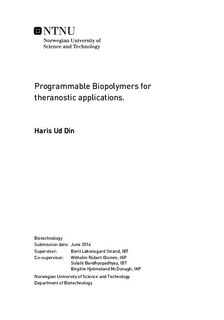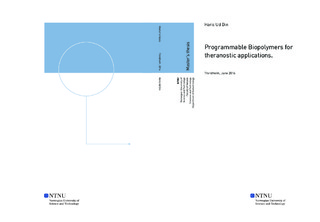| dc.description.abstract | Biopolymers hold great potential in drug delivery and tissue engineering applications. Alginates, a natural polysaccharide derived from brown algae, possess unique properties in terms of gel formation and their interaction with biological systems. Their physical and chemical properties can be tuned for desired functionalities for applications ranging from food to medicine. Alginate based systems can be used for targeted drug delivery. Targeted drug delivery and release of drug at the diseased site has become increasingly important to have effective therapeutic effect and limited toxicity. Alginates can be incorporated within nanoparticles (NPs) to avail of the functions from both the counterparts gelling properties from alginates and drug delivery and imaging applications from the multifunctional NPs. NPs are considered as an effective tool in nanomedicine due to their small size and unique optical properties. These multifunctional NP/alginate hybrids can be exploited to perform the desired theranostic function and revolutionize the field of medicine.
In this work, alginate gelation has been investigated in very dilute concentrations in the aqueous phase. CaCl2 was used as cross linker to facilitate binding of alginate α-L-guluronic (G) blocks to form a three dimensional gel network, especially at higher concentrations of CaCl2. Three different gelling architectures have been investigated after conducting a preliminary set of gelling experiments. These have been hypothesized as micro-aggregate, intermediate and gel phases respectively that show increasing fraction of gelled networks and are obtained with an increasing mole ratio of calcium ions to alginate. CaCl2 was observed to be the dominant factor in gelation and incorporation studies of alginate.
With an attempt to understand the role of surface properties of NPs on alginate gelling, three different Fe@Au NPs were synthesized. Characteristic LSPR peak for Fe@Au NPs was obtained at 526 nm and with an average hydrodynamic size of 74 ± 2.7 nm. Successful coating of the NPs with PEG and Poly Lysine (PL) were confirmed by an increase in hydrodynamic sizes of Fe@Au_PEG and Fe@Au_PL to 96 ± 1.3 nm and 124 ± 4.2 nm respectively. Fe@Au and Fe@Au_PEG NPs showed zeta potentials -45±0.8 mV and -26 ± 0.4 mV respectively, while Fe@Au_PL NPs were cationic with a zeta potential of and 27 ± 0.2 mV.
Interaction and binding of alginates with Fe@Au, Fe@Au_PEG, Fe@Au_PL was also studied. The physicochemical properties of these systems were mapped using UV-Vis spectroscopy, spectrofluorometry, viscometery, dynamic light scattering (DLS), zeta potential measurement & S(T)EM among other techniques. Higher concentration of the NPs led to higher incorporation inside the alginate networks. However, NP coating did not influence the gelation characteristics of the networks, and, thus, Fe@Au NPs was only used for the loading and release parts of the study.
Fluorescein sodium salt was used as a model dye both for supporting the hypothesized gel architectures, and for understanding loading and release from NP/alginate systems. Three methods were used to load the dye to the system. The difference between these methods relied on the relative order of forming dye-loaded NPs or alginates and incorporation of NPs into alginate networks.
Results have shown that Method 1, wherein, the dye was first loaded onto the Fe@Au NPs followed by incorporation of dye loaded NPs into the alginate networks, gave the highest loading and incorporation efficiency. Loading efficiency of the dye onto the Fe@Au NPs was 61 % whereas incorporation percentage of dye in the gel network was found to be 70 % for the gelling condition. Other loading methods also showed good loading and incorporation percentages significantly in gelling phase of alginate where dimerized G Block content are in excess. However, method 1 was chosen for carrying out further release experiments, since it gave highest loading for all the three different gelling architectures. Release of dye was investigated at laboratory conditions by simple diffusion method based on concentration gradient.
Consistent release was observed in gelling condition of 1 mg/ml Fe@Au dyed/alginate system with 27 % release of the dye after 20 hours. The release is estimated to be primarily diffusion-based. Other solutions show very abrupt release behavior which might be due to the measurement techniques used or due to the release setup used during the study. These NP-alginate systems have shown promising results for delivery of model dye, which could be further extended to study the release of specific drugs. Release can also be modulated using pH or temperature to combine diffusion with stimuli related response of these alginate-NP systems. | |

